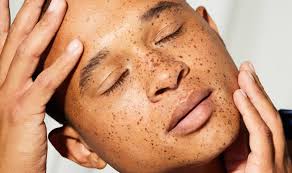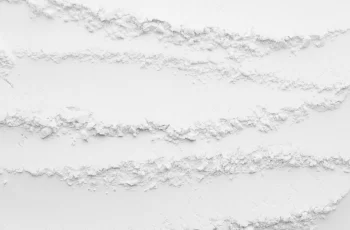
The Science of Sebum and Sebaceous Glands
Sebum is a natural oil that everyone produces in different amounts, depending on their skin type.
If you look in the mirror and notice an oily sheen on your face, then you know your skin is producing sebum.
While oily skin can be annoying and clog your pores, the oil on your skin – sebum – is beneficial in many ways.
Read on to learn the science behind oily skin and how sebum can affect your skin health.
Be sure to take the Baumann Skin Type Test, as most people misjudge their skin type! Find out if you have oily or dry skin for free today!
What is sebum?
Sebum is an oily substance produced by small glands in your skin called sebaceous glands. Sebum covers the surface of your skin and forms a protective barrier against environmental influences.
Its main job is to keep your skin soft and supple and prevent moisture loss.
Sebum also carries antioxidants like vitamin E to the surface of your skin. The average adult produces about 1 mg of sebum per 10 square centimeters of skin every three hours.
This naturally produced oil is essential for healthy skin hydration and barrier function.
What are sebaceous glands?
Sebaceous glands are tiny glands within hair follicles that produce and secrete sebum. Sebaceous glands are found throughout the skin, except on the palms, soles of feet, and lips.
The highest concentrations are on the scalp and face. Sebaceous glands are made up of specialized sebum-producing cells called sebocytes.
As sebaceous cells mature, they accumulate lipids, greatly increase in size, and eventually release sebum onto the surface of the skin.
What is sebum made of?
Sebum contains a mixture of lipids, including triglycerides, wax esters, squalene, free fatty acids, and small amounts of cholesterol.
The two main components are triglycerides and squalene. Triglycerides make up the largest proportion of sebum, about 57.5%.
They are broken down by skin bacteria into free fatty acids, some of which have antibacterial properties. Squalene, which makes up about 12% of sebum, is a powerful antioxidant.
Unfortunately, it oxidizes easily in air to form comedogenic squalene peroxides. Other antioxidants in sebum include coenzyme Q10 and vitamin E.
Other components, such as wax esters and fatty acids, help form the skin barrier.
Does sebum clog your pores?
While sebum is important for skin health, excessive oil production can lead to clogged pores and acne. An important component of sebum is squalene, which oxidizes in the air.
The product of this oxidation is called squalene peroxide, which causes comedone and clogs pores. Clogged pores combined with acne-causing bacteria trigger the inflammation associated with acne. People with excessive sebum production or “very oily skin” are most at risk for clogged pores and acne.
Does your diet affect your sebum?
Studies have shown that diet can affect sebum production. For example, diets high in sugar have been linked to increased sebum production.
One study found that men who consumed a low-glycemic diet had changes in the fatty acid composition of their sebum.
Other studies have shown that components of the Western diet, such as palmitic acid in dairy and meat, may activate the inflammatory process associated with acne.
Although further research is needed, a diet low in sugar, dairy, and meat appears to help reduce excess sebum production. Sebum and the Microbiome
The mixture of microorganisms that live on the skin is called the skin microbiome. The composition of sebum directly affects bacterial growth.
Sebum is a food source for some microbes, such as P. acnes, which digests various fats. P. acnes releases pro-inflammatory free fatty acids, which can cause acne.
On the other hand, the fatty acids in sebum have antimicrobial effects on P. acnes and other microbes.
The effect of sebum on the facial microbiome depends on factors such as your skin type, diet, and lifestyle.
Stress and Sebum Production
It is well known that stress hormones stimulate sebum production. For example, corticotropin-releasing hormone (CRH) binds to receptors in the sebaceous glands and increases sebum production.
CRH also promotes the conversion of precursor molecules into testosterone, which further increases oil production. Other stress-related molecules can also directly increase sebum production.
This explains why stress often triggers oily skin and acne. Stress management techniques can help control stress-related sebum production.
Antioxidants in Sebum
In addition to its protective and moisturizing effects, sebum contains antioxidants that prevent oxidative damage caused by free radicals.
The most important antioxidant is vitamin E. Since vitamin E is fat-soluble, sebum provides an ideal transportation system to the skin surface.
Sebum also contains other antioxidants, such as Coenzyme Q10. These antioxidants can protect the skin from oxidative stress and UV radiation.
Sebum and Skin Cancer
While sebum is primarily used to prevent dry skin, it can also protect against skin cancer in some cases.
Areas of the skin with fewer sebaceous glands, such as the lips, tend to be drier and have a higher risk of developing certain types of skin cancer.
On the other hand, when sebum oxidizes on the skin, it itself forms free radicals. This is why it is important to wash your face regularly if your face is chronically oily.
Why should you wash sebum off your face?
During the day, a thin layer of sebum can provide protection, but too much oil can lead to blemishes and a greasy appearance.
Sebum, sweat, dead skin cells, and environmental pollutants can clog pores and provide a breeding ground for acne bacteria.
Therefore, it is recommended to wash your face twice a day – this removes excess sebum, dirt, and bacteria from the surface of the skin.
The ideal cleanser is one that matches the natural pH of the skin. Here are some great antibacterial and salicylic acid cleansers:
[[C01, C08]]
Sebum clog?
Sebum prevents evaporation of water from the skin’s surface, but it is not as occlusive as mineral oil-based ingredients. However, it has occlusive properties that reduce water loss.
Although not completely occlusive, the sebum film on the skin’s surface slows evaporation and provides moisture.
People with very oily skin rarely suffer from dry skin because their sebum production creates an occlusive layer that locks in moisture.
If you have combination skin, your skin may only be oily occasionally.
Non-comedogenic Skincare for Oily Skin
If you have oily skin and don’t want to include comedogenic ingredients in your skincare routine, I have some advice for you!
This range of non-comedogenic skincare products has been developed specifically for acne-prone and oily skin types who need optimal regulation of sebum production.
Be sure to take the Baumann Skin Type Test to find the best products for your skin!
DQH Knowledge drop: In your 20s, your skin cell turnover decreases. (Cell turnover is a key component in keeping your skin youthful.) You know what else slows down? Your collagen production. Starting in your 20s, collagen decreases by about 1 percent per year. Should you want to prevent fine lines and wrinkles, start by eliminating behaviors that contribute to premature aging. “If it’s bad for you, it’s bad for your skin,” says dermatologist Michel Somenek.
“Cigarette smoking reduces blood flow to the skin and causes premature wrinkling and a dull skin texture. Making the repeated pursed motion to inhale can also cause smoker’s lines. Alcohol and recreational drugs are toxins for the skin that damage its cellular structure and DNA,” Somenek tells us. “The faster you eliminate vices while you are young, the better chance your skin and body have to recuperate.” Also, adopting an anti-aging routine in your 20s is key. After all, the best offense is a good defense. We spoke to Somenek and experts Joshua Ross and Audrey Kunin to find out more.
Keep reading for the best anti-aging products for your 20s, according to skincare professionals.
Sunscreen
“We all know that the sun is the number one cause of skin aging and starting the prevention in your 20s is very important,” Ross says. “The majority of your sun damage won’t start to appear until you’re in your 30s, so don’t wait until you see it surface or you’ll be behind the curve. Stay ahead of it with a good-quality zinc-based sunscreen worn daily.”
Farmacy Green Defense Daily Mineral Sunscreen
An invisible sunscreen with SPF 30, plus botanical extracts meant to protect skin with tons of antioxidants. Bonus: It’s clean and fine to use under makeup.
Bareminerals Complexion Rescue™ Tinted Moisturizer Broad Spectrum SPF 30
Although we recommend you use your SPF and moisturizer separately, we also understand moments when you don’t have time or energy for that extra step. For those times, this bareMinerals moisturizer is a great thing to have on hand.
Vitamin C Serum
“A great introduction to anti-aging is to start with a vitamin C serum in your morning skincare routine,” Ross says. “It’s a powerful antioxidant that will neutralize free radicals and brighten the skin.” He adds that it’s a great way to counteract the effects of the sun’s harmful rays, which, as previously mentioned, are among the biggest causes of premature aging.
Drunk Elephant C-Firma™ Vitamin C Day Serum
The Drunk Elephant C-Firma is a lightweight serum that promises to give skin a glow by combining the brightening powers of vitamin C with ferulic acid, l-ascorbic acid, and vitamin E. The included sodium hyaluronate is meant to replace hydration loss, so you shouldn’t have to deal with any irritation.
Sunday Riley C.E.O. Rapid Flash Brightening Serum
This potent serum is jam-packed with vitamin C (15 percent, to be exact), which means it’s a potential superstar at both brightening skin and dousing it in antioxidants.
Peptides
Using peptides on your skin has many benefits, says Somenek. “The skin barrier is what defends the body against pollution, UV rays, bacteria, and toxins. It can be damaged by several everyday factors. Using topical peptides aids in building a stronger barrier,” he says. “Peptides comprise elastic fibers, which are a type of protein. These fibers help to make skin appear taut and firm. Peptides can also help repair damaged skin, relieve inflammation, and even out skin tone. Some peptides can kill acne-causing bacteria that is common in 20-somethings.”
Kunin agrees, saying, “Peptides are an excellent entry point for supporting collagen.” She recommends looking for face and eye treatments that contain these collagen-boosting powerhouses.
Charlotte Tilbury Magic Eye Rescue Cream
This Charlotte Tilbury super-emollient eye cream has a base of coconut oil and shea butter (read: it’s incredibly hydrating). Botanicals plus peptides are meant to help reduce dark circles and boost collagen, respectively.
This creamy moisturizer serves up potent collagen-boosting peptides and pycnogenol, and antioxidant-rich vitamin C. “Instead of sitting on top of the skin, peptides penetrate the outer layer so they go deep. The ‘signals’ they send tell the cells to produce elastin and collagen, which are needed for youthful-looking skin,” explains Somenek.
At-Home Peel Pads
Remember that skin cell turnover fiasco we talked about earlier? One way to help support it is by exfoliating. “Exfoliation is important to help keep skin fresh and luminous,” Kunin says. She recommends using at-home peel pads as an easy and effective way to exfoliate.
“The goal in your 20s is to fight the slowing pace of cell turnover. It is wise to use products that gently exfoliate, yet still remove oil and other impurities. Products that have Alpha Hydroxy Acids (AHA) or Beta Hydroxy Acids (BHA) are a good choice.”
According to Somenek, you should only exfoliate two to three times a week. “People of all ages are guilty of over-exfoliating and that can be too much of a good thing,” he says.
Dermadoctor Kakadu C Intensive Vitamin C Peel Pad
A few swipes of this Derma Doctor powerful peel pad promise to leave your skin glowing and smooth, thanks to the seven (yes, seven) types of chemical exfoliants, including AHA and BHA. It also contains vitamin C via Kakadu plum extract for added brightening and antioxidant protection.
KEY INGREDIENTS Kakadu plum extract is sourced from the Kakadu plum, a fruit grown in northern Australia. It contains vitamin C, which restores the skin’s natural barrier, increases collagen production, and soothes irritation.
Dr. Dennis Gross Skincare Alpha Beta® Universal Daily Peel Pads
These are the gold standard of peel pads, with a cult following and over 900 five-star reviews on Sephora. They’re easy to use and contain a blend of anti-aging exfoliating acids.
Emollient Night Cream
“In your 20s, you need to start upping the hydration in your skincare routine. You may have been cautious of over-moisturizing because of acne in your teens, but as you enter your 20s, your skin transitions and becomes drier,” Ross says. “I recommend an emollient night cream added into your evening skincare regimen.”
“Twenty-somethings need to make sure that they are not using creams that will clog their pores and cause excess oil production,” says Somenek. Opt for non-comedogenic products.
Cerave Skin Renewing Night Cream
One great choice is the CeraVe Skin Renewing Night Cream, which is a non-comedogenic night cream that leaves skin soft and glowy. It combines the moisturizing powers of ceramides and hyaluronic acid.
RoC Retinol Correxion Max Hydration Creme
“The best night cream ingredients contain retinol, benzoyl peroxide, and/or salicylic acid or hyaluronic acid. The goal is to moisturize, yet remove excess oil,” says Somenek. This Roc Retinol Correxion cream fits the bill as it contains both hyaluronic acid and retinol so it promises to moisturize while also being non-comedogenic.



